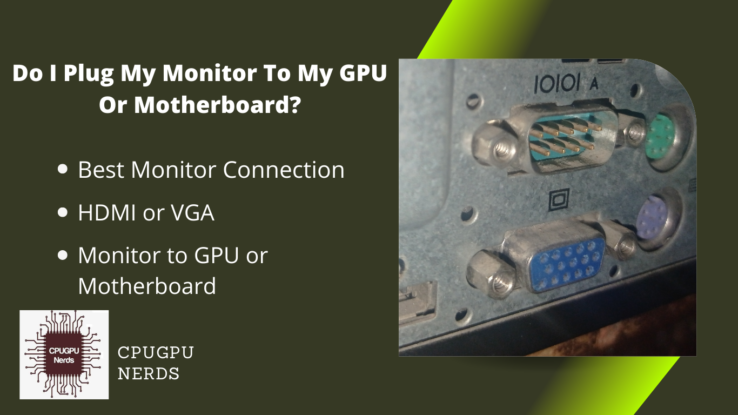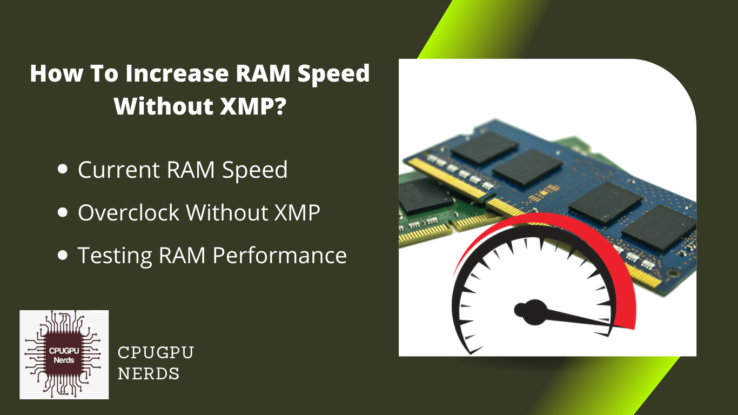Any good desktop experience requires a good monitor. Monitors are essential to enjoy the system you have, and it makes sense to want to know where you should plug it. There are many different types of monitors available on the market – some different demanding levels of power to be utilized to their full extent.
Often, many people who intensively use their desktops have more than one monitor. This could be for several reasons, either to help work more efficiently or enjoy a game much better. This leads you to different options when it comes to where you have to plug your monitor.
Do I Plug My Monitor To My GPU Or Motherboard?
If you have a dedicated graphics card – you definitely want to plug it into the GPU. As such, it is better to ignore any HDMI ports that are available on the motherboard. Doing so allows you to extract the best performance from your dedicated graphics processor instead of wearing out your motherboard over time.
Sometimes you will observe that your dedicated graphics card has a DVI port rather than an HDMI port. This is not an issue. You can simply use an adaptor and still plug in your monitor to your GPU.
Your GPU has greater processing power for graphics and will provide you with a much smoother and richer experience on your monitor. After all, that is its main purpose. Attaching it to the motherboard instead of the GPU can significantly differ, especially if you are gaming.
If you connect the monitor to your motherboard’s VGA connection, you’ll get a low-resolution display and won’t be able to use your Graphics Card. However, with the help of an adapter, you may connect your monitor to your graphics card for a very low price. Check Amazon for various options or get it from a local computer store.
Determine which ports are available on your graphics card first. HDMI and DisplayPort (DP) connections are common on modern graphics cards. Use a VGA to HDMI or VGA to DP converter, depending on which available port. Manufacturers are gradually phasing out VGA and DVI connections (well, it has already been faced out). VGA and DVI ports will be found on the majority of older devices.
If you connect the monitor directly to the motherboard, you’ll only get a simple onboard display with low resolution. It’s worth noting that if your CPU doesn’t have built-in graphics, it might not work. It is preferable to connect the monitor to the Graphic card via an adapter rather than the motherboard’s VGA connector because the Graphic card will support a higher resolution (don’t forget to install the necessary graphic card drivers).
If you have an older monitor, it is recommended to purchase a new monitor that supports the same updated display connectors as your graphics card. However, if you’re on a budget, a converter adaptor is the way to go.
Does Plugging Your Monitor To The GPU Improve Gaming?
Yes, games often require extensive processing power that only a dedicated GPU can effectively provide to them. Therefore plugging in your monitor to the GPU will provide you with a much smoother gaming experience with optimal graphics for your system. GPUs are made to handle this kind of processing burden.
If this burden is directed towards the motherboard instead, your gaming experience will take a hit. You might experience reduced graphics, as well as unsmooth gameplay. The processing power required to fully realize the game’s capacity cannot usually be handled by a motherboard.
Is It Okay To Plug The Monitor Into The Motherboard?
Yes, as long as you’re not doing a lot of intensive work. You will not notice a significant difference if you’re simply browsing the web or streaming videos. You can still enjoy a smooth experience in those conditions as those activities do not require a lot of processing power. It will be fine for normal PC use.
Be careful, though. This does not apply if you have to use your monitor/system for intensive work – even other than gaming. Graphic designing and video editing software can also be very demanding. Therefore, connecting your monitor to your GPU under that circumstance is recommended to extract the best experience.
Use your dedicated GPU for what you purchased it for. If you force your CPU to use onboard or iGPU graphics, you’ll likely cause it to overheat, and you’ll gain little performance over a dedicated GPU unless you buy a low-end one. This may be an exception if you have a low-end dedicated GPU and an AMD Ryzen CPU from the 2000G or 3000G family. Then your integrated GPU, such as a GT 1030 or GT 730, or even earlier GT series NVIDIA GPUs, may well outperform the dedicated one.
If you really aren’t in the mood for gaming, won’t be using any demanding software, and just want a display, then your iGPU is a fine option. This is because an integrated graphics card will always consume less power and dissipate less heat as compared to a dedicated graphics card. So, if you are planning to not use any demanding software for an extended period of time, using your iGPU may not be the worst choice. However, do note that you’ll need to keep replugging everything which can get cumbersome.
Should I Plug My Second Monitor into My GPU or Motherboard?
Plug it into your GPU. This will give you the best experience. You should ideally plug any and all monitors that you are using into your GPU in order to extract a smoother experience from them and utilize them to their fullest extent. Your motherboard does not have a dedicated graphics unit to support the processing burden.
By plugging your monitor into your motherboard, you will simply be using its integrated graphics processing unit rather than the dedicated GPU available to you. But, of course, if there is no dedicated GPU in the first place, then you will have no display at all.
If you’re going to use the second monitor for gaming, make sure it’s connected to the GPU. Unfortunately, that burden is too much for the inbuilt iGPU on the CPU to handle.
When both monitors are connected to the PC, you may need to turn on the second monitor in display settings. It’s also conceivable that the iGPU is turned off, which is a setting found in many motherboards’ BIOS. If you wish to use the motherboard graphics port, ensure it’s turned on.
Conclusion
We can see how it is beneficial to connect your monitor to your GPU rather than your motherboard in most circumstances. However, when you’re doing activities such as gaming or work like video editing, the best experience can only be extracted by using a dedicated graphics unit. The integrated GPUs available on some motherboards are usually insufficient to support the processing power required for some of these activities and will thus give you a poorer experience.
Your dedicated graphics cards are made for this reason. So do not hesitate from connecting your different monitors to the GPU to enjoy the best possible experience. If an adaptor is required in some cases, it is always beneficial to use one instead of using the HDMI adaptors on the motherboard.

Hey, I’m Hammad. I write for this website to help you with the IT advice about PC, RAM, CPU, Motherboard, PSU, and other PC components.
I will provide detailed guides with images, and explain step by step so you can understand the process. Check all my articles here.



